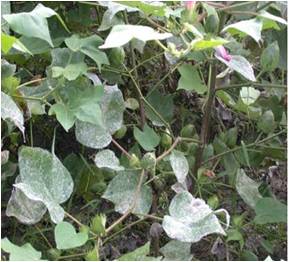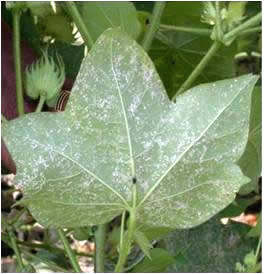Symptom
- Irregular to angular pale translucent lesions bound by veinlets and grey powdery growth appear on lower surface of leaf
- Correspondingly light green specks appear on the upper surface of leaves.
- In severe cases whitish grey powdery growth appear on upper surface. The affected leaves dry up inward, turn yellow and fall prematurely.
Survival and Mode of Spread
- The pathogen survives during summer in the infected crop residues. The perennial cotton plants and self-sown cotton plants also harbour the pathogen.
- Primary spread is through conidia from infected plant debris.
- Secondary spread is through wind, rain splash, irrigation water and implements.
Favourable Conditions
- Wet humid conditions during winter cotton season
- Intermittent rains during North-East monsoon season
- Low temperature (20-30 0C) during October-January
- Close planting
- Excessive application of nitrogenous fertilizers
- Very early sowing or very late sowing of cotton
Management
- Remove and burn the infected crop residues.
- Remove the self-sown cotton plants during summer months.
- Avoid excessive application of nitrogenous fertilizers/manures.
- Adopt correct spacing based on soil conditions and varieties.
- Spray Wettable sulphur @ 400 g /acre or Chlorothalonil@ 200 g / acre or Difenaconazole @ 100 ml or Kresoxim Methyl @ 200 ml/ acre or Tebuconazole @ 200 ml/ acre or Propiconazole @ 200 ml/acre or Metiram 55% + Pyraclostrobin 5% WG @ 200g/ acre or Azoxystrobin 18.2% + Difenoconazole 11.4% w/w SC 200ml/ acre at 60, 90 and 120 days after sowing.
Source of Information
- Online resources
- CPG 2020
|
 |
 |
Whitesh grey powdery growth |
|


